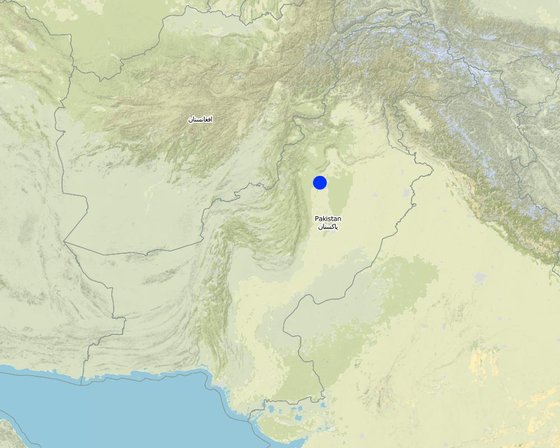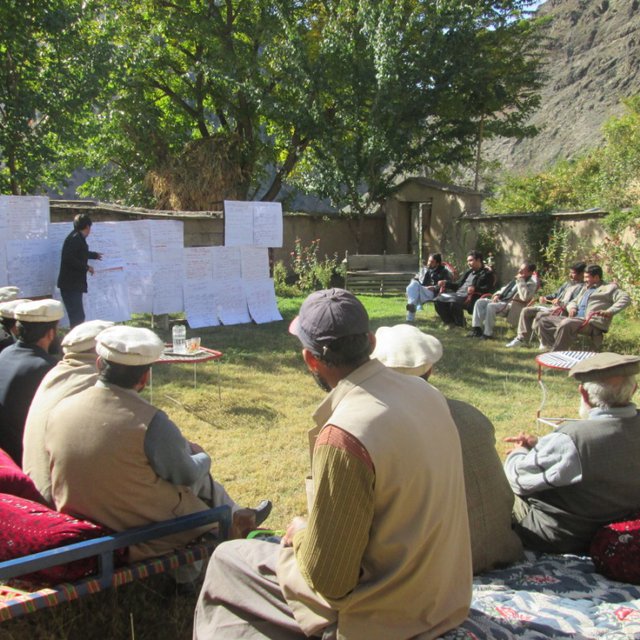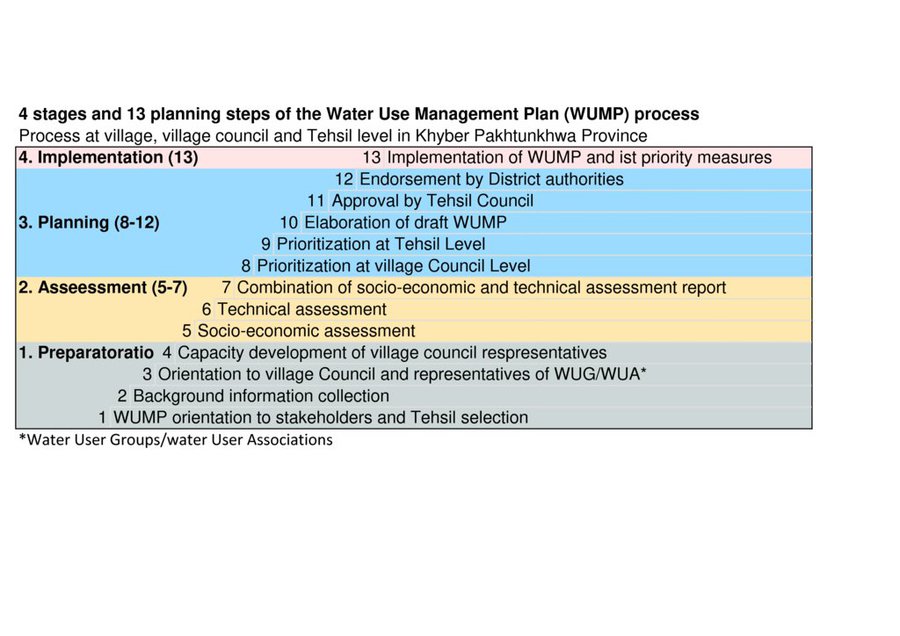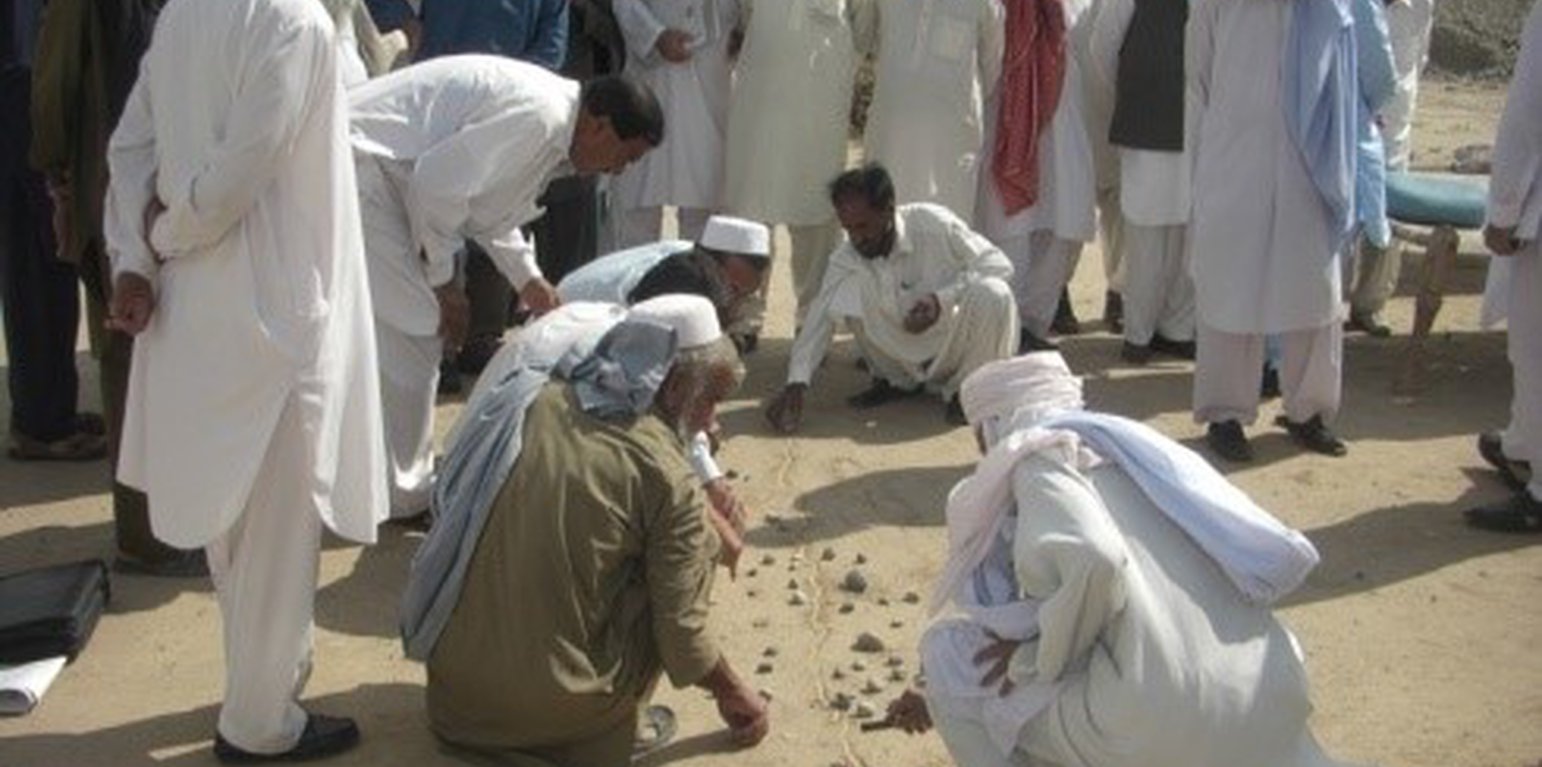Water Use Management Plan (WUMP)
(ປາກິດສະຖານ)
WUMP
ຄຳອະທິບາຍ
The overall purpose of WUMP is to compile an inventory of available water ressources in a particular geographical or administrative area, to identify communities' priorities in order to achieve an effective, equitable and efficient use of water resources at local level. This approach promotes a participatory and inclusive analysis and implementation of measures for a sustainable management of water, land and related resources.
The WUMP approach has the following specific objectives:
- to assess water available resource, existing uses and requirements
- to determine water access rights and equity issues through inclusive and interactive dialogues
- to plan and manage water resources - considering multiple needs and uses - in a participatry manner.
- to prioritise required measures, considering climate change and disaster risks
- to promote coordinated water resource development for different stakeholders
- to promote a sustainable use of water, protecting water resources and preservation of the environment
- to strengthen local institutions
- to include economically and socially disadvantaged groups
- to promote an interactive dialogue for improvement of regulatory frameworks and policies in the water sector.
The methode involves field visits by field team to collect information from the community, which is done through focus group discussion, preparation of village maps, social and technical questionnaires
The WUMP process consists of four main stages: 1) Preparation; 2) Assessment/analysis of information ; 3) Planning ; 4) Implementation (see flow chart with according sub-steps).
The process and results of a WUMP:
Is based on a participatory process, which promote inclusiveness. It fosters coordination and collaboration among different local stakeholders including government, communities and private sector and helps to establish the baseline situation and a comun understanding. Land users and other local actors appreciate this approach as it promotes a participatory, transparent process for an equitable distribution of water and a sustainable management of water related resources. The approach helps to overcome potential economic or socio-cultural barriers, by providing a comun space for joint analysis, discussion and solution finding by facilitating interaction between stakeholders of different contexts.
ສະຖານທີ່

ສະຖານທີ່: Dera Ismail Khan Thensil (sub-division), Khyber Pakhtunkhwa (province), ປາກິດສະຖານ
ການຄັດເລືອກພື້ນທີ່ ທີ່ອີງໃສ່ຂໍ້ມູນທາງພູມີສາດ
ວັນທີເລີ່ມຕົ້ນ: 2014
ປີຂອງການສິ້ນສຸດ: 2019
ປະເພດຂອງແນວທາງ
-
ພື້ນເມືອງ / ທ້ອງຖີ່ນ
-
ການລິເລີ່ມ ພາຍໃນປະເທດ ທີ່ຜ່ານມາ / ນະວັດຕະກໍາ
-
ພາຍໃຕ້ໂຄງການ / ແຜນງານ

Important actors participating in Water Use Management Plan data collection through focus group discussion (Muhammad Yousaf)

Important actors participating in Water Use Management Plan data collection through focus group discussion (Muhammad Yousaf)
ເປົ້າໝາຍຂອງແນວທາງ ແລະ ການປົກປັກຮັກສາສິ່ງແວດລ້ອມ
ເປົ້າໝາຍ / ຈຸດປະສົງຫຼັກໃນການຈັດຕັ້ງປະຕິບັດແນວທາງ
The main aim of the WUMP approach is to assess the availability of water resources, existing uses/demands and future requirements/needs. The WUMP helps to address water access, equity issues and balance these rights through interactive dialogues within the community and other local stakeholders. The WUMP approach contributes therefore actively to water governance and improved management of natural resources.
ເງື່ອນໄຂທີ່ສະໜັບສະໜູນໃຫ້ການຈັດຕັ້ງປະຕິບັດເຕັກໂນໂລຢີ ບົນພື້ນຖານແນວທາງ
-
ສັງຄົມ / ວັດທະນະທໍາ / ມາດຕະຖານ ແລະ ຄຸນຄ່າທາງສາສະໜາ: The approach helps to overcome potential economic or socio-cultural barriers, by providing a comun space for joint analysis, discussion and solution finding by facilitating interaction between stakeholders of different contexts.
-
ມີຄວາມສາມາດ / ເຂັ້າເຖິງຊັບພະຍາກອນດ້ານການເງິນ ແລະ ການບໍລິການ: The implementation of the WUMP tends to increase access to water for production purposes with a positive impact for households/ communities' income.
The results of the WUMP process with its according priorities of intervention are recognized by local government and reflected in local annual development plans and according budgets.
- the WUMP defines options for other actors to investment in water sector based on communities' priorities.
-
ການກໍ່ຕັ້ງສະຖາບັນ: WUMP is steered by the district Coordination Committee at district level having representative from all concerned government departments, Water User Association including women members, representatives from civil society where they adress key issues and take decisionsof the local water sector.
-
ການຮ່ວມມື / ການປະສານງານຂອງຜູ້ກ່ຽວຂ້ອງ: Collaboration among actors is the central element of the WUMP, which pomotes a coordinated water resource development involving different stakeholders: communities and government and non-governmental organizations. The process, enables local institutions to consider needs and participation of economically and socially disadvantaged groups.
-
ກ່ຽວກັບກົດໝາຍ (ສິດນໍາໃຊ້ດິນ, ສິດນໍາໃຊ້ນໍ້າ): WUMP addresses and defines solutions on water access & equity issues through interactive dialogues.
-
ນະໂຍບາຍ: WUMP can influence sector policies at local level based on the collections of baseline data and evidence, which contributes to improve frame conditions. Topics, priorities and challenges of the WUMP are addressed with stakeholders at district Coordination Committee, which can actively influence policies of the water sector.
-
ຄວາມຮູ້ກ່ຽວກັບການຄຸ້ມຄອງ ທີ່ດິນແບບຍືນຍົງ, ການເຂົ້າເຖິງການສະໜັບສະໜູນ ທາງດ້ານວິຊາການ: The local stakeholders, namely communities are directly involved in the implementation of the WUMP, which improves their knowledge about SLM.
ເງື່ອນໄຂທີ່ເຊື່ອງຊ້ອນໃຫ້ການຈັດຕັ້ງປະຕິບັດເຕັກໂນໂລຢີ ບົນພື້ນຖານແນວທາງ
ການມີສ່ວນຮ່ວມ ແລະ ບົດບາດຂອງພາກສ່ວນທີ່ກ່ຽວຂ້ອງທີ່ມີສ່ວນຮ່ວມ
ພາລະບົດບາດຂອງພາກສ່ວນທີ່ກ່ຽວຂ້ອງ ທີ່ມີສ່ວນຮ່ວມໃນການຈັດຕັ້ງປະຕິບັດແນວທາງ
| ແມ່ນໃຜ / ພາກສ່ວນໃດ ທີ່ເປັນເຈົ້າການ ໃນການຈັດຕັ້ງປະຕິບັດ ວິທີການ? |
ລະບຸ ພາກສ່ວນທີ່ກ່ຽວຂ້ອງ |
ພັນລະນາ ບົດບາດ ໜ້າທີ່ ຂອງພາກສ່ວນທີ່ກ່ຽວຂ້ອງ |
| ຜູ້ນໍາໃຊ້ດິນໃນທ້ອງຖິ່ນ / ຊຸມຊົນທ້ອງຖິ່ນ |
Rural local communities, water & land users |
Participation as an integral part in preparation at village level. Contribution to the assessment, prioritisation and implementation of the interventions
|
| ອົງການຈັດຕັ້ງ ພາຍໃນຊຸມຊົນ |
Water user associations (WUA)/ water users groups (WUG)
|
Responsible to support and facilitate the WUMP process, social support, provision of primary information. Ensure participation and involvement of all WUA members. Coordinate with relevant authorities and other development actors to identify technical and financial support in their area / water sector.
|
| ຜູ້ຊ່ຽວຊານ ການນຄຸ້ມຄອງ ທີ່ດິນແບບຍືນຍົງ / ທີ່ປຶກສາດ້ານກະສິກໍາ |
staff of the Water for Livelihoods Project : WUMP coordinator (engineer, male, 53 years), senior engineer (engineer, male, 43 years) |
Coaching and guidance at all level, steering of WUMP process in collaboration with District Government, organize trainings as scheduled, support field teams for the collection of technical and social information/data. |
| ອົງການຈັດຕັ້ງ ທີ່ບໍ່ຂື້ນກັບລັດຖະບານ |
Local partner NGO
|
Project implementation, social mobilisation and interaction at field level to ensure that the social dimension, local concerns deserving support are adressed and that the water user association (WUA) are inclusive and gender concerns are duly represented. Support water user associations in their advocacy efforts to mobilize resources for WUMP. |
| ພາກເອກະຊົນ |
Consultant
|
Compilation of data, collected information and writing of WUMP |
| ອໍານາດ ການປົກຄອງທ້ອງຖິ່ນ |
District Authorities / Administration |
Provision of legal and administrative acceptance, recognition and support to WUMP implementation. Support through provision of timely technical services to water user association /groups in WUMP implementation, validation of information (data regarding drinking water supply, irrigation, water use efficiency, soil conservation by Public Health Engineering Department, Irrigation Department, On Farm Water Management Department, Soil Conservation Department ). Participation to ensure a participatory monitoring and provide feedback to the district govt. for improvements in delivering of water sector services. |
| ພະນັກງານຂັ້ນສູນກາງ (ຜູ້ວາງແຜນ, ຜູ້ສ້າງນະໂຍບາຍ) |
District and provincial governments |
Policy dialogue counter-part to address WUMP issues, which require a change in policies, coordination and engagement with in-line authorities and to allocate resources for the integration and implementation of WUMP in the district development plan (ADP). |
| ອົງການຈັດຕັ້ງ ສາກົນ |
Swiss Agency for Development and Cooperation (SDC) |
Financial ressources. Partner for advocacy and policy dialogues to address key topics in the water sector in their policy dialogue with national government representatives. |
ອົງການທີ່ເປັນຕົວແທນໃນການຈັດຕັ້ງປະຕິບັດ
Water for Livelihoods Project
ການລວບລວມເອົາຜູ້ນໍາໃຊ້ທີ່ດິນໃນທ້ອງຖິ່ນ/ຊຸມຊົນທ້ອງຖິ່ນ ໃນການຈັດຕັ້ງປະຕິບັດແນວທາງ ແຕ່ລະໄລຍະ
ບໍ່ມີ
ການບໍ່ປະຕິບັດ
ການຊ່ວຍເຫຼືອຈາກພາຍນອກ
ການຮ່ວມມື
ການນໍາໃໍຊ້ເອງ
ການເລີ່ມຕົ້ນ / ແຮງຈູງໃຈ
Community through water user association (WUA) and water user group (WUG) in their actvities: support and facilitate the WUMP, ensure that all WUGs are involved in the process, link with relevant authorities and other development actors for technical and financial support development.
ການວາງແຜນ
Community: WUA/WUG in their activities: Participate as an integral part in the preparation of WUMP at village level. Contribute to conducting feasibility, implementation and execution of interventions.
ການປະຕິບັດ
Community: WUA/WUG in their activities: Support a system for cost contribution by the community. Link with relevant authorities and other development actors for seeking the technical and financial support in their area water sector development. Promote and advocate for sustainable development in the water sector.
ຕິດຕາມກວດກາ / ການປະເມີນຜົນ
Community: WUA/WUG in their activities: Ensure equitable water rights and promote good water governance principles. Ensure strong linkages with WUA/community through regular meetings and documentation of decisions.
ແຜ່ນວາດສະແດງ
The process of WUMP is divided into 4 stages consisting of 13 steps

ຜູ້ຂຽນ: Syed Hussain Mustafa, Khan Muhammad, Tawheed Gul, Munawar Khan Khattak
ການຕັດສິນໃຈໃນການເລືອກເຕັກໂນໂລຢີ ການຄຸ້ມຄອງທີ່ດິນແບບຍືນຍົງ
ການຕັດສິນໃຈໂດຍ
-
ຜູ້ນໍາໃຊ້ດິນຜູ້ດຽວ (ການລິເລີ່ມດ້ວຍຕົນເອງ)
-
ຜູ້ນໍາໃຊ້ທີ່ດິນຫຼັກ, ການສະໜັບສະໜູນ ໂດຍຜູ້ຊ່ຽວຊານ ການນໍາໃຊ້ທີ່ດິນແບບຍືນຍົງ
-
ພາກສ່ວນກ່ຽວຂ້ອງທັງໝົດ, ເປັນສ່ວນໜຶ່ງ ຂອງວິທີທາງແບບມີສ່ວນຮ່ວມ
-
ຜູ້ຊ່ຽວຊານ ຫຼັກດ້ານການຄຸ້ມຄອງ ທີ່ດິນແບບຍືນຍົງ, ມີການຕິດຕາມປຶກສາຫາລືກັບຜູ້ນໍາໃຊ້ທີ່ດິນ
-
ຊຽ່ວຊານ ສະເພາະດ້ານການຄຸ້ມຄອງ ດິນແບບຍືນຍົງຜູ້ດຽວ
-
ນັກການເມືອງ / ຜູ້ນໍາ
ການຕັດສິນໃຈບົນພື້ນຖານ
-
ປະເມີນເອກກະສານ ຄວາມຮູ້ກ່ຽວກັບ ການຄຸ້ມຄອງ ທີ່ດິນແບບຍືນຍົງ (ຫຼັກຖານທີ່ຊ່ວຍໃນການຕັດສິນໃຈ)
-
ຜົນທີ່ໄດ້ຮັບ ຈາກການຄົ້ນຄວ້າ
-
ປະສົບການສ່ວນບຸກຄົນ ແລະ ຄວາມຄິດເຫັນ (ທີ່ບໍ່ເປັນເອກກະສານ)
ການສະໜັບສະໜູນເຕັກໂນໂລຢີ, ການສ້າງຄວາມອາດສາມາດ ແລະ ການຄຸ້ມຄອງຄວາມຮູ້
ກິດຈະກຳ ດັ່ງລຸ່ມນີ້ ແມ່ນເປັນພາກໜຶ່ງຂອງແນວທາງ
-
ການສ້າງຄວາມສາມາດ / ການຝຶກອົບຮົມ
-
ການບໍລິການໃຫ້ຄໍາປຶກສາ
-
ສະຖາບັນການສ້າງຄວາມເຂັ້ມແຂງ (ການພັດທະນາອົງການຈັດຕັ້ງ)
-
ຕິດຕາມກວດກາ ແລະ ປະເມີນຜົນ
-
ການຄົ້ນຄວ້າ
ການສ້າງຄວາມອາດສາມາດ / ຝຶກອົບຮົມ
ໄດ້ສະໜັບສະໜູນຝຶກອົບຮົມໃຫ້ແກ່ພາກສ່ວນກ່ຽວຂ້ອງດັ່ງລຸ່ມນີ້
-
ຜູ້ນໍາໃຊ້ດິນ
-
ພະນັກງານພາກສະໜາມ / ທີ່ປຶກສາ
-
Government department specilist (SLM)
ຮູບແບບການຝຶກອົບຮົມ
-
ການເຮັດຕົວຈິງ
-
ຕົວຕໍ່ຕົວ
-
ເນື້ອທີ່ສວນທົດລອງ
-
ກອງປະຊຸມ
-
ຫຼັກສູດ
ກວມເອົາຫົວຂໍ້
Water resources conservation, efficient use of water resources, irrigation water distribution/ scheduling.
ການບໍລິການທາງດ້ານການໃຫ້ຄໍາປຶກສາ
ໄດ້ຮັບການບໍລິການທາງດ້ານການໃຫ້ຄໍາປຶກສາ
-
ໃນພື້ນທີ່ຂອງຜູ້ນໍາໃຊ້ດິນ
-
ສູນຄົ້ນຄວ້າ
SLM specialist made field visits and provided technical guidance to Land Users
The Land Users visited relevant organizations for technical guidance
ຄວາມເຂັ້ມແຂງຂອງສະຖາບັນ
ສະຖາບັນ ໄດ້ຮັບການສ້າງຄວາມເຂັ້ມແຂງ
-
ບໍ່ມີ
-
ມີ, ໜ້ອຍໜຶ່ງ
-
ມີ, ພໍສົມຄວນ
-
ມີ, ຫຼາຍ
ໃນລະດັບດັ່ງລຸ່ມນີ້
-
ທ້ອງຖິ່ນ
-
ລະດັບພາກພື້ນ
-
ແຫ່ງຊາດ
ອະທິບາຍສະຖາບັນ, ພາລະບົດບາດແລະຄວາມຮັບຜິດຊອບ, ສະມາຊິກ, ແລະອື່ນໆ.
Water User Association (WUA, local Institutions) at district & sub-district level were strengthened. The legally recognize WUA and Apex of the WUA take gradually responsibilities to support and facilitate the WUMP process. The WUAs strives for improvements in the water sector and are a catalyst to bring together and pool communities, civil society organisations, local authorities and other actors of different actors for to address water issues and development options.
ຮູບແບບການສະໜັບສະໜູນ
-
ທາງດ້ານການເງິນ
-
ການສ້າງຄວາມອາດສາມາດ / ການຝຶກອົບຮົມ
-
ອຸປະກອນ
ລາຍລະອຽດເພີ່ມເຕີມ
Project provided trainings for 16 Water User Associations (WUAs) and 3 Apex WUAs in Chitral, Karak, and DI Khan. These 16 associations aim to improve development in the water sector, to improve water governance to contribute to resolutions in case of disputes amongst different water right holders for an equitable access to water at local and at district level.
Through these trainings, the WUGs/ WUAs members representing various groups/ associations - including representatives from Government Line Agencies are trained in community management & skill training, mediation in case of water disputes, monitoring/documentation and health/hygiene.
ການຕິດຕາມ ແລະ ປະເມີນຜົນ
The principle of the monitoring, is to actively engage the communities associations (WUA/WUG) and capture their observations and concerns.
This is done through direct feedbacks from communities, during regular field visits and interaction with technical departments, who receive feedbacks from communities based on regular exchanges.
ການສະໜັບສະໜູນທາງດ້ານການເງິນ ແລະ ອຸປະກອນຈາກພາຍນອກ
ງົບປະມານປະຈຳປີ ໃນກິດຈະກຳ ການຄຸ້ມຄອງທີ່ດິນແບບຍືນຍົງ ທີ່ເປັນສະກຸນເງິນໂດລາ
-
< 2,000
-
2,000-10,000
-
10,000-100,000
-
100,000-1,000,000
-
> 1,000,000
Precise annual budget: n.a.
The cost for the preparation of WUMP depends on the size of the area
ການບໍລິການ ຫຼື ສິ່ງກະຕຸກຊຸກຍູ້ ດັ່ງລຸ່ມນີ້ ແມ່ນໄດ້ສະໜອງໂດຍຜູ້ນຳໃຊ້ທີ່ດິນເອງ
-
ການສະໜັບສະໜູນ ທາງດ້ານການເງິນ / ອຸປະກອນ ສະໜອງໃຫ້ແກ່ຜູ້ນໍາທີ່ດິນ
-
ຫຼຸດປັດໃຈນໍາເຂົ້າ
-
ສິນເຊື່ອ
-
ສິ່ງຈູງໃຈ ຫຼື ເຄື່ອງມືອື່ນໆ
ເງິນສະໜັບສະໜູນອຸປະກອນ / ສະໜອງໃຫ້ຜູ້ຊົມໃຊ້ທີ່ດິນ
The project and governamental counter parts (Department) provide material and technical support. The community provides in-kind contribution through labor and local material for the imlementation of the measures/ technology.
ການວິເຄາະຜົນກະທົບ ແລະ ສະຫຼຸບລວມ
ຜົນກະທົບຂອງການນໍາໃຊ້ແນວທາງ
ບໍ່
ມີ, ໜ້ອຍໜຶ່ງ
ມີ, ພໍສົມຄວນ
ມີ, ຫຼາຍ
ວິທີທາງ ຊ່ວຍຊຸກຍູ້ ຜູ້ນຳໃຊ້ທີ່ດິນທ້ອງຖີ່ນ, ໃນການປັບປຸງ ການມີສ່ວນຮ່ວມ ຂອງຜູ້ທີ່ກ່ຽວຂ້ອງ ບໍ່?
The approach supports land and water users to make decisions regarding water use by their own.
ການນໍາໃຊ້ ວິທີທາງ ດັ່ງກ່າວນີ້ ສາມາດເປັນຫຼັກຖານ ທີ່ສະໜັບສະໜູນ ໃຫ້ການຕັດສິນໃຈໄດ້ບໍ່?
The preparation stage includes an analysis, where information for evidence and later decisions is collected.
Once the effectiveness of the approach is recognized, it can be replicated by other communities them-selfs.
ການຈັດຕັ້ງປະຕິບັດ ວິທີທາງ ສາມາດຊ່ວຍຜູ້ນໍາໃຊ້ທີ່ດິນ ໃນການຈັດຕັ້ງປະຕິບັດ ແລະ ບໍາລຸງຮັກສາ ເຕັກໂນໂລຢີ ການຄຸ້ມຄອງ ທີ່ດິນແບບຍືນຍົງໄດ້ບໍ?
Land users are involved for the implementation and maintenance of the prioritized measures in the WUMP plan, which an efficient use water for productiion and drinking purposes.
ການນໍາໃຊ້ ວິທີທາງ ສາມາດປັບປຸງ ການປະສານງານ ແລະ ຄ່າໃຊ້ຈ່າຍ ການຈັດຕັ້ງປະຕິບັດ ທີ່ມີປະສິດທິພາບ ຂອງການຄຸ້ມຄອງ ທີ່ດິນແບບຍືດຍົງໄດ້ບໍ່?
The WUMP provides options for cost sharing mechanisms amongst different actors, to attract funding for prioritized initiatives. The prioritized initiatives of WUMP are jointly implemented by different stakeholders, which can reduce its costs.
ການນໍາໃຊ້ ວິທີທາງ ສາມາດລະດົມ ຫຼື ປັບປຸງ ການເຂົ້າເຖິງຊັບພະຍາກອນ ການເງິນ ສໍາລັບການຈັດຕັ້ງປະຕິບັດ ການຄຸ້ມຄອງ ທີ່ດິນແບບຍືດຍົງໄດ້ບໍ່?
The results of WUMP (measures) are included in the official departmental annual development plans and budgets.
ການນໍາໃຊ້ ວິທີທາງ ສາມາດປັບປຸງຄວາມຮູ້ ແລະ ຄວາມສາມາດຂອງຜູ້ນໍາໃຊ້ທີ່ດິນ ໃນການປະຕິບັດ ການຄຸ້ມຄອງ ທີ່ດິນແບບຍືດຍົງໄດ້ບໍ່?
The land and water users learnt how to analyse and assess water resources. They learnt about options to address the identified challenges.
ການນໍາໃຊ້ ວິທີທາງ ສາມາດປັບປຸງຄວາມຮູ້ ແລະ ຄວາມສາມາດ ຂອງພາກສ່ວນທີ່ກ່ຽວຂ້ອງໄດ້ບໍ່?
Similarly, all other involved stakeholders' learn how to analysse and asses water resources and know about options to address them.
ການນໍາໃຊ້ ວິທີທາງ ສາມາດສ້າງຄວາມເຂັ້ມແຂງ ໃຫ້ສະຖາບັນການຈັດຕັ້ງ, ການຮ່ວມມື ລະຫວ່າງພາກສ່ວນທີ່ກ່ຽວຂ້ອງບໍ່?
By establishing a district coordination committee to steer the approach (WUMP) all stakeholders can jointly discuss, address their needs and suggest options to be prioritized.
ການນໍາໃຊ້ ວິທີທາງ ສາມາດຫຼຸດຜ່ອນ ຂໍ້ຂັດແຍ່ງໄດ້ບໍ່?
Through this approach all stakeholders - especially the up-stream & down stream users - can resolve their water related disputes through dialogue. This contributes to resolve disputes between communities and concerned department.
ການຈັດຕັ້ງປະຕິບັດ ວິທີທາງ ສາມາດສ້າງຄວາມເຂັ້ມແຂງ ທາງສັງຄົມ ແລະ ເສດຖະກິດບໍ່?
Disadvantaged groups participate in the preparation process of the plan, where they reflect and contribute with their concerns, needs and priorities.
ການຈັດຕັ້ງປະຕິບັດ ວິທີທາງ ສາມາດປັບປຸງ ຄວາມສະເໜີພາບ ຂອງບົດບາດ ຍິງຊາຍ ແລະ ສ້າງຄວາມເຂັ້ມແຂງໃຫ້ຜູ້ຍິງໄດ້ບໍ່?
Same participation as the disadvantaged groups. Women are also part of the decision making body.
ການຈັດຕັ້ງປະຕິບັດ ວິທີທາງ ສາມາດຊຸກຍູ້ ຜູ້ນໍາໃຊ້ທີ່ດິນທີ່ເປັນຊາວໜຸ່ມ / ຄົນລຸ້ນໃໝ່ ໃນການຄຸ້ມຄອງ ທີ່ດິນແບບຍືນຍົງໄດ້ບໍ?
Same participation as the disadvantaged groups. Generall people of the age group 30-45 have are the leader of associations - supported by their elders - to address and develop water ressouce management of their villages.
ການນໍາໃຊ້ ວິທີທາງ ໄດ້ປັບປຸງ ການຄໍ້າປະກັນສະບຽງອາຫານ ຫຼື ປັບປຸງໂຄສະນາການໄດ້ບໍ່?
Through the approach water efficient technologies are promoted, which allow to increase production and improve food security.
ການນໍາໃຊ້ ວິທີທາງ ໄດ້ປັບປຸງ ການເຂົ້າເຖິງນໍ້າ ແລະ ສາຂາພິບານໄດ້ບໍ່?
Through the approach options to improve access to water for domestic use are promoted. Access to clean drinking water at households' proximity contributes to improved sanitation.
ການຈັດຕັ້ງປະຕິບັດ ວິທີທາງ ສາມາດສ້າງຄວາມອາດສາມາດໃຫ້ຜູ້ນໍາໃຊ້ດິນ ໃນການປັບຕົວ ຕໍ່ການປ່ຽນແປງດິນຟ້າອາກາດ / ຫຼດຜ່ອນຄວາມສ່ຽງທາງໄພພິບັດໄດ້ບໍ?
The result of the WUMP approach is a set of options, where efficient use of water and water saving technologies are promoted e.g. water harvesting.
ສິ່ງກະຕຸກຊຸກຍູ້ໃຫ້ຜູ້ນໍາໃຊ້ທີ່ດິນ ໃນການປະຕິບັດການຄຸ້ມຄອງທີ່ດິນແບບຍືນຍົງ
-
ການຜະລິດເພີ່ມຂຶ້ນ
-
ກໍາໄລເພີ່ມຂຶ້ນ (ຄວາມສາມາດ), ການປັບປຸງຄ່າໃຊ້ຈ່າຍ, ຜົນປະໂຫຍດ, ອັດຕາສ່ວນ
-
ຫຼຸດຜ່ອນດິນເຊື່ອມໂຊມ
-
ຫຼຸດຜ່ອນຄວາມສ່ຽງຂອງໄພພິບັດ
-
ການຫຼຸດຜ່ອນພາລະວຽກ
-
ການຊໍາລະເງິນ / ເງິນອຸດໜູນ
-
ກົດລະບຽບແລະລະບຽບການ (ລະອຽດ) / ການບັງຄັບໃຊ້
-
ກຽດສັກສີ, ຄວາມກົດດັນທາງສັງຄົມ / ການຕິດຕໍ່ກັນທາງສັງຄົມ
-
ລວມເຂົ້ານໍາກັນກັບການເຄື່ອນໄຫວ / ໂຄງການ / ກຸ່ມ / ເຄືອຂ່າຍ
-
ຄວາມຮັບຮູ້ ທາງສີ່ງແວດລ້ອມ
-
ພາສີ ແລະ ຄວາມເຊື່ອຖື, ສົມບັດສິນທໍາ
-
ການປັບປຸງ ຄວາມຮູ້ ແລະ ຄວາມສາມາດ ຂອງການຄຸ້ມຄອງ ທີ່ດິນແບບຍືນຍົງ
-
ການປັບປຸງຄວາມງົດງາມ
-
ການຫຼຸດຜ່ອນຂໍ້ຂັດແຍ່ງ
ຄວາມຍືນຍົງຂອງການຈັດຕັ້ງປະຕິບັດກິດຈະກໍາຂອງແນວທາງ
ຜູ້ນໍາໃຊ້ທີ່ດິນ ສາມາດຈັດຕັ້ງປະຕິບັດຕາມແນວທາງໄດ້ເອງບໍ່ (ໂດຍປາດສະຈາກການສະໜັບສະໜູນຈາກພາກສ່ວນພາຍນອກ)?
For the prioritisation of technologies implemented through WUMP, options which require only minimal external inputs and are easy to sustain by the land user, where promoted.
ບົດສະຫຼຸບ ແລະ ບົດຮຽນທີ່ໄດ້ຮັບ
ຄວາມເຂັ້ມແຂງ: ທັດສະນະມູມມອງ ຂອງຜູ້ນໍາໃຊ້ທີ່ດິນ
-
Participatory and inclusive process, which ensures ownership by local actors, promotes coordination and fosters partnerships between different actors.
-
The proritized measures selected through the WUMP approach promote a sustainable use of water resources through water conservation and efficient water use.
ຄວາມເຂັ້ມແຂງ: ທັດສະນະມຸມມອງ ຂອງຜູ້ປ້ອນຂໍ້ມູນເອງ
-
Strengthening of local institutional capacities, establishment ofan inventory/ data used as base line in the water sector.
-
Flexible for improvement, since the WUMP is reviewed each 3-5 year
-
Officially recognized and accepted planning tool at regional level, which provides opportunities for investment by other actors based on communities' priorities.
ຈຸດອ່ອນ / ຂໍ້ເສຍ / ຄວາມສ່ຽງ: ທັດສະນະມູມມອງ ຂອງຜູ້ນໍາໃຊ້ທີ່ດິນວິທີການແກ້ໄຂແນວໃດ
-
Time consuming preparation process, high initial cost for the preparation
Ensure regular feature of planing (continuous process)
-
Lack of technical capacities at local level
Capacity building trainings of local institutions (VOs/ WUAs/WUGs) in planning. Provide suport at local level through the project and government extension services.
ຈຸດອ່ອນ / ຂໍ້ເສຍ / ຄວາມສ່ຽງ: ທັດສະນະມຸມມອງ ຂອງຜູ້ປ້ອນຂໍ້ມູນເອງວິທີການແກ້ໄຂແນວໃດ
-
Replication and upscaling require talor-made adjustments
Technical capacity building of govt. departments.
-
WUMP application in large scale in areas (big catchment areas, limited access)
Lobbying for support and resources at different governmental level.
-
Important mobilisation of resources by other stakeholders for implementation
Inclusion of WUMP priorities by the govt. department in their respective annual development plans.
ເອກກະສານອ້າງອີງ
ການທົບທວນຄືນ
-
Alexandra Gavilano
-
Nicole Harari
-
Hanspeter Liniger
ວັນທີຂອງການປະຕິບັດ: Nov. 25, 2016
ປັບປຸງລ່າສຸດ: Oct. 4, 2017
ບຸກຄົນທີ່ສໍາຄັນ
-
Munawar Khan (mkkhattak@helvetas.org.pk) - ຜູ້ຊ່ຽວຊານ ດ້ານການຄຸ້ມຄອງ ທີ່ດິນແບບຍືນຍົງ
ການບັນຍາຍລາຍລະອຽດ ໃນຖານຂໍ້ມູນ ຂອງ WOCAT
ຂໍ້ມູນການເຊື່ອມໂຍງຂໍ້ມູນການຄຸ້ມຄອງການນໍາໃຊ້ດິນແບບຍືນຍົງ
ເອກກະສານ ແມ່ນໄດ້ອໍານວຍຄວາມສະດວກໂດຍ
ສະຖາບັນ
- HELVETAS (Swiss Intercooperation)
ໂຄງການ
- Book project: where people and their land are safer - A Compendium of Good Practices in Disaster Risk Reduction (DRR) (where people and their land are safer)
ເຊື່ອມໂຍງກັບ ຂໍ້ມູນຕ່າງໆ ທີ່ກ່ຽວຂ້ອງທີ່ມີ







